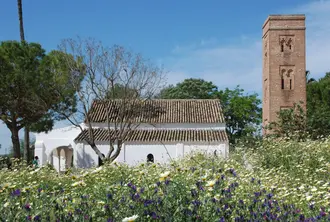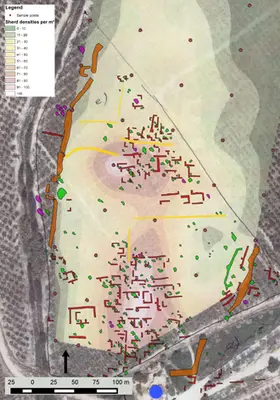Cuatrovitas (Bollullos de la Mitación, Seville, Spain): Field research on an Almohad settlement and mosque
The Project
In a cooperate research project, the University of Bamberg and the University of Sevilla have investigated the former mosque, presently church of the ‘Ermita de Cuatrovitas’ (municipality of Bullulos de la Mitación, province of Sevilla) and the associated abandoned medieval settlement. During several campaigns of field research (2013–2015 and 2017–2018), a wide range of research methods and techniques was applied: survey prospection, archaeological excavation in more than two dozen trenches, as well as traditional and technically advanced techniques of building documentation (3D laser scan), supplemented by pollen analysis, zoological and anthropological analyses. Previous research on this site had consisted in small-scale mapping of the former mosque and its minaret, and in limited exploration of structures in the vicinity of the building. The minaret of the former mosque has parallels in other monuments of the Almohad period regarding its construction and the polylobed double arcades on its façades. It has been emblematic for the site, now associated with the Holy Virgin of Cuatrovitas.
The Almohad mosque
The mosque has been partially preserved in the present little church building, although many alterations and 20th-century restorations have obscured its original appearance. Its prayer hall consisted of a three-aisled nave with horseshoe arcades in five bays. While the exterior walls were originally built of rammed earth, the miḥrāb niche, protruding from the south side, was constructed on foundations of massive ashlar. The courtyard to the north of the mosque was certainly very small, whereas a larger walled area extended on its eastern side. On the north-eastern corner of the mosque precinct, the brick minaret has been preserved with little changes of the Almohad substance; it can be reconstructed with a recessed top on the platform.
Burials and tunnel caves
Several burials around the mosque/church building give evidence about the population of Cuatrovitas and about the transition from Islamic to Christian faith after the conquest of 1248. Oral tradition had long provided hints to the existence of subterranean structures on the site. Apart from bell-shaped cellars or cisterns that were probably common throughout the settlement, significant remnants of a tunnel system were discovered near the church in 2017. It is most likely that these subterranean galleries with their narrow entrance shafts were used during times of crisis and immediate threat.
Earlier and later phases
Archaeological finds documented during the campaigns are the first to demonstrate that the habitation of Cuatrovitas also predates the Almohad period. On multiple locations, older pit fills were secured, and pre-Almohad material could be documented among more recent finds in horizontal filling layers. This pre-Almohad material consists, among others, of 10th and 11th century ceramics and single finds of the emiral period (8th century). These thus clearly indicate that there must have been a pre-Almohad settlement, even if concerning building structures could not (yet) be localized.
A post-Almohad stage was recognized from the time after the Christian reconquest and establishment of Castilian power in 1248. The environment of the sacral building, by then converted from mosque into church, was in use as a graveyard, as several burials confirm. These can be attributed Christians according to burial positions. Ceramics dating from the second half of the 13th century only offer a few sherds of the so called transition ceramics, produced by Islamic potters near the street of Gibraltar. These ceramics in themselves do not allow unequivocal conclusions on the religion of their posessors, so that the cultural characteristics of this period remain to be determined more closely. In the the 14th century, late-medieval ‘Christian’ ceramics are clearly dominating and were found after all in layers close to the little church, former mosque of Cuatrovitas.
Publications:
Anja Heidenreich - Magdalena Valor Piechotta - Alejandro Jiménez - Lorenz Korn: Cuatrovitas (Bollullos de la Mitación, Sevilla, Spanien). Neue Untersuchungen zur almohadenzeitlichen Moschee und Wüstung - Ein Beitrag zur Geschichte der Siedlungskammer Aljarafe in islamischer Zeit, Madrider Mitteilungen 56, 2016, 410-505.
Anja Heidenreich, Cuatrovitas - Eine hochmittelalterliche Landmoschee mit Dorfwüstung westlich von Sevilla (Spanien), in: Patrick Cassitti (Hrsg.) Festschrift für Prof. Ingolf Ericsson zum 60. Geburtstag (Bonn 2017) 125-154.
Anja Heidenreich – Alejandro Jiménez Hernández: Neue hochmittelalterliche Erdstollen westlich von Sevilla. Südliche Beispiele für das mitteleuropäische Phänomen des Erdstalls? Madrider Mitteilungen 61, 2021, 78–110.
Anja Heidenreich (ed.): Cuatrovitas (Bollullos de la Mitación, Prov. of Seville, Spain).
New investigations into the Almohad mosque and abandoned village. Studien zur islamischen Kunst und Archäologie 4 (Wiesbaden 2022).
Anja Heidenreich (ed.): Cuatrovitas (Bollullos de la Mitación, Prov. Sevilla). Nuevas investigaciones sobre el asentamiento abandonado y la mezquita almohade (Bollullos de la Mitación 2022).




